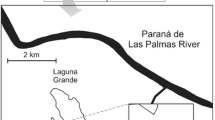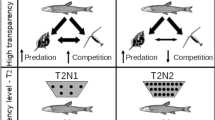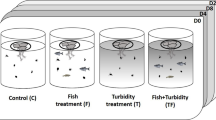Abstract
This work explores the reasons why predation plays a minor role in structuring phytoplankton composition in a Neotropical shallow lake. Phytoplankton, zooplankton, and fish were sampled from a shallow lake over the course of a year, and the stomach contents of 80 individuals of the dominant omnivorous–planktivorous fish species were analyzed. The field study was complemented with a 5-day microcosm experiment in which the predation effects of micro, meso, and macrozooplankton were measured. Stomach content analysis revealed that fish predation was high, and primarily comprised by Cladocera (Ivlev’s index >0.75). Both meso and macrozooplankton fractions are able to feed on colonial cyanobacteria, silica cell-wall organisms (<35 µm), and mixotrophic flagellate (>35 µm). Macrozooplankton, however, can feed on single cells, mucilaginous colonies, non-mucilaginous colonies, and silica cell-wall organisms (>35 µm) (P < 0.05 in all cases). Our results support the idea that absence of predation on phytoplankton is mainly mediated by fish predation on zooplankton and morpho-functional characteristics of algae which prevent zooplankton predation; showing fish a lack of direct predation effect on phytoplankton.





Similar content being viewed by others
References
Benndorf, J., W. Böing, J. Koop & I. Neubauer, 2002. Top-down control of phytoplankton: the role of time scale, lake depth and trophic state. Freshwater Biology 47: 2282–2295.
Beveridge, M. C. & D. J. Baird, 2000. Diet, feeding and digestive physiology. In Beveridge, M. C. M. & B. J. McAndrew (eds), Tilapias: Biology and Exploitation. Kluwer, Liege: 59–87.
Bonetto, A. & A. Martinez de Ferrato, 1966. Introducción al estudio del zooplancton de las cuencas isleñas del Paraná Medio. Physis 26: 385–396.
Boverí, M. B. & R. Quirós, 2002. Trophic interactions in Pampean shallow lakes: evaluation of silverside predatory effects on mesocosm experiemnts. Verhandlungen der Internationalen Vereinigung fur Theoretische und Angewandte Limnologie 28: 1274–1278.
Caparroy, P., U. Høgsbro Thygesen & A. W. Visser, 2000. Modelling the attack success of planktonic predators: patterns and mechanisms of prey size selectivity. Journal of Plankton Research 22: 1871–1900.
Carpenter, S. R., J. F. Kitchell, J. R. Hodgson, P. A. Cocharan, J. J. Elser, M. M. Elser, D. M. Lodge, D. Kretchmer, X. He & C. N. Von Ende, 1987. Regulation of lake primary productivity by food web structrure. Ecology 68: 1863–1876.
Chase, J. M., 2003. Strong and weak trophic cascades along a productivity gradient. Oikos 101: 187–195.
Cyr, H., 1998. Cladoceran and copepod-dominated zooplankton communities graze at similar rate in low productivity lakes. Canadian Journal of Fisheries and Aquatic Sciences 55: 414–422.
Devercelli, M. & V. Williner, 2006. Diatom grazing by Aegla uruguayana (Decapoda:Anomura:Aeglidae): digestibility and cell viability after gut passage. Annales de Limnologie – International Journal of Limnology 42: 73–77.
DeVries, D. R. & R. A. Stein, 1992. Complex interactions between fish and zooplankton: quantifying the role of an open-water planktivore. Canadian Journal of Fisheries and Aquatic Sciences 49: 1216–1227.
Drenner, R. W., S. T. Threlkeld & M. D. McCracken, 1986. Experimental analysis of the direct and indirect effects of an omnivorous filter-feeding clupeid on plankton community structure. Canadian Journal of Fisheries and Aquatic Sciences 43: 1935–1945.
Dumont, H. J., I. Van de Velde & S. Dumont, 1975. The dry weight estimate of biomass in a selection of Cladocera, Copepoda and Rotifera from the plankton, periphyton and benthos of continental waters. Oecologia 19: 79–97.
Dussart, B. H. & D. Defaye, 2001. Introduction to the Copepoda. Backhuys, Leiden.
Eskinazi-Sant’Anna, E. M., P. M. Maia-Barbosa & F. A. R. Barbosa, 2002. On the natural diet of Daphnia laevis in the eutrophic Pampulha Reservoir (Belo Horizonte, Minas Gerais). Brazilian Journal of Biology 62: 445–452.
Fernández, E. M., R. A. Ferriz, C. A. Bentos & G. R. López, 2012. Dieta y ecomorfología de la ictiofauna del arroyo Manantiales, provincia de Buenos Aires, Argentina. Revista del Museo Argentino de Ciencias Naturales 14: 1–13.
Fernando, C. H., 1994. Zooplankton, fish and fisheries in tropical freshwaters. Hydrobiologia 272: 105–123.
Ferriz, R. A., C. A. Bentos, E. M. Fernández & G. R. López, 2011. Reproducción y dinámica poblacional de Cheirodon interruptus (Ostariophysi: Characidae) en el arroyo El Portugués, alta cuenca del río Samborombón, Argentina. Latin American Journal of Aquatic Research 39: 151–160.
Frau, D., F. Rojas Molina, M. Devercelli & S. José de Paggi, 2013. The effect of an invading filter-feeding bivalve on a phytoplankton assemblage from the Paraná system: a mesocosm experiment. Marine and Freshwater Behaviour and Physiology 45: 303–316.
Frau, D., F. Rojas Molina & G. Mayora, 2016. Feeding selectivity of the invasive mussel Limnoperna fortunei (Dunker, 1857) on a natural phytoplankton assemblage: what really matters? Limnology 17: 47–57.
Gagneten, A. M., A. L. Ronchi, F. Rojas Molina & R. Sobrero, 2000. Aportes al conocimiento del ambiente acuático de la Reserva Ecológica de la Ciudad Universitaria “EL POZO” Y de su diversidad zooplanctonica. FABICB 4: 111–122.
Gillooly, J. S. & S. I. Dodson, 2000. Latitudinal patterns in the size distribution and seasonal dynamics of new world, freshwater cladocerans. Limnology and Oceanography 45: 22–30.
González, E. J., 1998. Natural diet of zooplankton in a tropical reservoir (El Andino reservoir, Venezuela). Verhandlungen des Internationalen Verein Limnologie 26: 1930–1934.
González, E. J., 2000. Nutrient enrichment and zooplankton effects on the phytoplankton community in microcosms from El Andino reservoir (Venezuela). Hydrobiologia 434: 81–96.
Hamza, W., P. Pandolfi & M. I. Taticchi, 1995. Planktonic interactions and their role in describing the trophic status of a shallow lake in Central Italy (Lake Trasimeno). Memorie dell’Istituto Italiano di Idrobiologie 53: 125–139.
Havens, K. E., J. R. Beaver & T. L. East, 2007. Plankton biomass partitioning in a eutrophic subtropical lake: comparison with results from temperate lake ecosystems. Journal of Plankton Research 29: 1087–1097.
Hillebrand, H., C. Dürselen, D. Kirschtel, U. Pollingher & T. Zohary, 1999. Biovolume calculation for pelagic and benthic microalgae. Journal of Phycology 35: 403–424.
Iglesias, C., N. Mazzeo, G. Goyenola, C. Fosalba, F. Teixeira de Mello, S. García & E. Jeppesen, 2008. Field and experimental evidence of the effect of Jenynsia multidentata, a small omnivorous–planktivorous fish, on the size distribution of zooplankton in subtropical lakes. Freshwater Biology 53: 1797–1807.
Iglesias, C., N. Mazzeo, M. Meerhoff, G. Lacerot, J. M. Clemente, F. Scasso, C. Kruk, G. Goyenola, J. Garcia-Alonso, S. L. Amsinck, J. C. Paggi, S. J. Paggi & E. Jeppesen, 2011. High predation is of key importance for dominance of small-bodied zooplankton in warm shallow lakes: evidence from lakes, fish exclosures and surface sediments. Hydrobiologia 667: 133–147.
Ivlev, V. S., 1961. Experimental Ecology of the Feeding of Fishes. Yale University Press, New Haven.
Jakobsen, H. H., 2001. Escape response of planktonic protists to fluid mechanical signals. Marine Ecology Progress Series 214: 67–78.
José de Paggi, S. & J. C. Paggi, 2008. Hydrological connectivity as a shaping force in the zooplankton community of two lakes in the Paraná River floodplain. International Review of Hydrobiology 93: 659–678.
Ke, Z., P. Xie, L. Guo, Y. Liu & H. Yang, 2007. In situ study on the control of toxic Microcystis blooms using phytoplanktivorous fish in the subtropical Lake Taihu of China: a large fish pen experiment. Aquaculture 265: 127–138.
Kozlowsky-Suzuki, B., M. Karjalainen, M. Lehtiniemi, J. Engström-Öst, M. Koski & P. Carlsson, 2003. Feeding, reproduction and toxin accumulation by the copepods Acartia bifilosa and Eurytemora affinis in the presence of the toxic cyanobacterium Nodularia spumigena. Marine Ecology Progress Series 249: 237–249.
Lacerot, G., C. Kruk, M. Luerling & M. Scheffer, 2013. The role of subtropical zooplankton as grazers of phytoplankton under different predation levels. Freshwater Biology 58: 494–503.
Lazzaro, X., M. Bouvy, R. A. Ribeiro-Filho, V. S. Oliviera, L. T. Sales, A. R. M. Vasconcelos & M. R. Mata, 2003. Do fish regulate phytoplankton in shallow eutrophic Northeast Brazilian reservoirs? Freshwater Biology 48: 649–668.
Leadbeater, B. S. C. & J. C. Green, 2003. The Flagellate: Unity, Diversity and Evolution. Taylor and Francis, London.
Lehman, J. T., 1988. Selective herbivory and its role in the evolution of phytoplankton growth strategies. In Sandgren, C. D. (ed.), Growth and Reproductive Strategies of Freshwater Phytoplankton. Cambridge University Press, Cambridge: 369–387.
Levine, S. N., M. A. Borchardt, M. Braner & A. D. Shambaugh, 1999. The impact of zooplankton grazing on phytoplankton species composition and biomass in lake champlain (USA-Canada). Journal of Great Lakes Research 25: 61–77.
Lewis, W. M., 1976. Surface: volume ratio, implications for phytoplankton morphology. Science 192: 885–887.
Litchman, E., P. De Tezanos Pinto, C. A. Klausmeier, M. K. Thomas & K. Yoshiyama, 2010. Linking traits to species diversity and community structure in phytoplankton. Hydrobiologia 653: 15–28.
McQueen, D. J., M. R. S. Johannes, J. R. Post, T. J. Stewart & D. R. S. Lean, 1989. Bottom-up and top-down impacts on freshwater pelagic community structure. Ecological Monographs 59: 289–309.
Obertegger, U., H. A. Smith, G. Flaim & R. L. Wallace, 2011. Using the guild ratio to characterize pelagic rotifer communities. Hydrobiologia 662: 157–162.
Okun, N., J. Jandeson Brasil, L. Attayde & I. A. S. Costa, 2008. Omnivory does not prevent trophic cascades in pelagic food webs. Freshwater Biology 53: 129–138.
Panosso, R., P. Carlsson, B. Kozlowsky-Suzuki, S. M. F. O. Azevedo & E. Granéli, 2003. Effect of grazing by a neotropical copepod Notodiaptomus, on a natural cyanobacterial assemblage and on toxic and non-toxic cyanobacterial strains. Journal of Plankton Research 25: 1169–1175.
Porter, K. G., 1975. Viable gut passage of gelatinous green algae ingested by Daphnia. Verhandlungen des Internationalen Verein Limnologie 19: 2840–2850.
Reynolds, C., 2006. Ecology of Phytoplankton. Cambridge University Press, Cambridge.
Ringuelet, R. A., 1975. Zoografía y Ecología de los peces de aguas continentales y consideraciones de las áreas ictiológicas de América del Sur. Ecosur 2: 1–122.
Ruttner-Kolisko, A., 1977. Suggestions for biomass calculation of plankton rotifers. Archiv für Hydrobiologie 8: 71–76.
Salmaso, N., 2002. Ecological patterns of phytoplankton assemblages in Lake Garda: seasonal, spatial and historical features. Journal of Limnology 61: 95–115.
Salmaso, N. & J. Padisak, 2007. Morpho-Functional Groups and phytoplankton development in two deep lakes (Lake Garda, Italy and Lake Stechlin, Germany). Hydrobiologia 578: 97–112.
Sarma, S. S. S., S. Nandini & R. D. Gulati, 2005. Life history strategies of cladocerans: comparisons of tropical and temperate taxa. Hydrobiologia 542: 315–333.
Scasso, F., N. Mazzeo, J. Gorga, C. Kruk, G. Lacerot, J. Clemente, D. Fabián & S. Bonilla, 2001. Limnological changes of a sub-tropical shallow hypertrophic lake during its restoration. Two years of whole-lake experiments. Aquatic Conservation: Marine and Freshwater Ecosystems 11: 31–44.
Sinistro, R., 2010. Top-down and bottom-up regulation of planktonic communities in a warm temperate wetland. Journal of Plankton Research 2: 209–220.
Sommer, U. & H. Stibor, 2002. Copepoda – Cladocera – Tunicata: the role of three major mesozooplankton groups in pelagic food webs. Ecological Research 17: 161–174.
Sommer, U., F. Sommer, B. Santer, C. Jamieson, M. Boersma, C. Becker & T. Hansen, 2001. Complementary impact of copepods and cladocerans on phytoplankton. Ecology Letters 4: 545–550.
Sommer, U., F. Sommer, B. Santer, E. Zllner, K. Jrgens, C. Jamieson, M. Boersma & K. Gocke, 2003. Daphnia versus copepod impact on summer phytoplankton: functional compensation at both trophic levels. Oecologia 135: 639–647.
Tackx, M. L., P. J. M. Herman, S. Gasparini, Z. Irigoien, R. Billiones & M. H. Daro, 2003. Selective feeding of Eurytemora affinis (Copepoda, Calanoida) in temperate estuaries: model and field observations. Estuarine, Coastal and Shelf Science 56: 305–311.
Utermöhl, H., 1958. The improvement of quantitative phytoplankton methodology (in German). Mitteilungen Internationale Vereinigung für Theoretische und Angewandte Limnologie 9: 1–38.
Vanni, M. J., 2002. Nutrient cycling by animals in freshwater ecosystems. Annual Review of Ecology and Systematics 33: 341–370.
Venrick, E. L., 1978. How many cells to count? In Von Sournia, A. (ed.), Phytoplankton Manual. UNESCO, Paris: 167–180.
Von Rückert, G. & G. Giani, 2008. Biological interactions in the plankton community of a tropical eutrophic reservoir: is the phytoplankton controlled by zooplankton? Journal of Plankton Research 30: 1157–1168.
Weithoff, G., 2003. The concepts of ‘plant functional types’ and ‘functional diversity’ in lake phytoplankton – a new understanding of phytoplankton ecology? Freshwater Biology 48: 1669–1675.
Zhang, X., P. Xie, L. Hao, N. C. Guo, Y. G. Gon, X. L. Hu, J. Chen & G. D. Liang, 2006. Effects of the phytoplanktivorous silver carp (Hypophthalmichthy molitrixon) on plankton and the hepatotoxic microcystins in an enclosure experiment in a eutrophic lake, Lake Shichahai in Beijing. Aquaculture 257: 173–186.
Acknowledgments
We gratefully thank anonymous reviewers who improved this manuscript with their comments. We also want to thank to Dr. Paula de Tezanos Pinto for linguistic assistance. This manuscript was supported by the Universidad Nacional del Litoral (Project: CAI + D 14-78).
Author information
Authors and Affiliations
Corresponding author
Additional information
Handling editor: Judit Padisák
Rights and permissions
About this article
Cite this article
Frau, D., Battauz, Y. & Sinistro, R. Why predation is not a controlling factor of phytoplankton in a Neotropical shallow lake: a morpho-functional perspective. Hydrobiologia 788, 115–130 (2017). https://doi.org/10.1007/s10750-016-2991-4
Received:
Revised:
Accepted:
Published:
Issue Date:
DOI: https://doi.org/10.1007/s10750-016-2991-4




